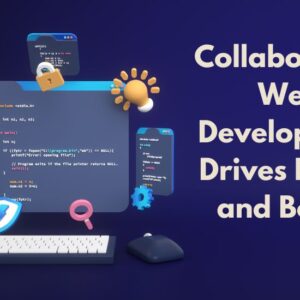Today, the business world is more than just a business—it's an empire. The internet has provided us with a way to connect with people across the world at lightning-fast speeds. It's allowed us to increase our marketing footprint and reach more people in less time, without ever having to leave the office.
But today, if you're not online, you're missing out on an opportunity to build your brand and engage with potential customers in ways that were never possible before.
And it's not like there aren't any options out there. There are hundreds of websites out there dedicated solely to helping you start a business! Some of them are even free!
But which one should you choose? Well, that depends on what your goals are as a company: Do you want to market yourself on social media? Do you want to be able to host video conferences with clients? Do you need a platform where your team can collaborate while they work remotely?
The truth is that there's no one right answer—every business has different needs when it comes time for their website redesign! That's why we created Freelancebazar, because we know how difficult it can be trying to find.
As the web development industry has evolved, so have the expectations of users. With new technologies and devices, website owners are looking for new ways to keep their sites up-to-date, fresh, and current. In order to meet these new needs, Texas-based website designing company Freelancebazar has taken a look at the trends in web design and development.
One of the biggest changes in this industry is that technology is changing so quickly that websites need to be updated frequently—every few months at least—to stay relevant. This means that designers must have a deep understanding of how people use their products online and be able to adapt content accordingly.
Another trend is that websites need to be mobile-friendly now more than ever before. Many users prefer using their phones or tablets over desktop computers because they are easier on their eyes and wrists than traditional laptops or desktops. This means that website owners will need to spend time making sure their sites appeal equally well to all devices, especially tablets with larger screens than phones (such as iPads).
The website designing company in Texas has seen the transition of website and evolution in the web development industry. As things advanced in the industry with technology the expectations of users have grown. Although technology has eased website design and development, it has also increased complexity for designers as well.
In addition to this, the new generation of website designs is simpler than ever before. The use of flat design and minimalist elements is popular among modern websites today. Moreover, there is a need for faster loading times because of high bandwidth usage by mobile devices.
In the world of web design, there are many factors that go into making a site run smoothly. One of the biggest expectations every user tends to have is optimized website speed and performance. The website design company Texas has observed that users tend to wait for a fraction of a second and if the website fails to access or keeps loading—users jump off to competitors. This increases the bounce rate.
Bounce rate is one of the most important metrics in website performance. It indicates how much traffic your site receives per session and how long it takes them to leave your site once they get on it. If you want to increase your bounce rate, then you need to look at ways by which you can improve your website's load speed as well as make sure that your content is mobile-friendly so that people can access it from any device at any time without disturbing their experience with other devices like computers, etc.
If you're having trouble getting your website to load fast enough, it could be because the web server is busy and can't handle the traffic. Or maybe the site is just slow to start up.
Whatever the reason, a website designing company in Texas can help you get your site up and running fast by optimizing its performance.
Our team of experts has years of experience working with web servers, and we know exactly what it takes to boost your website's speed performance. We'll optimize your code so that everything loads quickly—even if it's not currently on the same server!
1. Website Maintenance is a crucial element of any successful business.
You've probably heard the saying "don't mess with success." But things change when your website is successful.
When you have a website, there are so many people relying on it that you need to make sure that it is maintained and updated as much as possible. Even after your website goes live, there are still people who use it, and they need to be able to get to their favorite pages easily. If you're not being proactive about making sure this happens, then eventually your site will fall behind in the race for online traffic, which can have serious consequences for your business: loss of revenue, bad press coverage, etc.
The good news is that maintaining your website is easy once you know how to do it! Here are some tips on how to keep your site running smoothly:
1. Have a backup plan: Make sure that you have a backup plan in case there is any issue with your site.
2. Check your images regularly: Check your images every day and make sure they are loaded correctly and that there are no broken images on your site.
3. Use tools like Google Chrome or Firefox that give you an alert when there is an error on your page; this way you can fix it immediately and not get affected by it later on during heavy traffic hours which might slow down your site even more than what it already is!
You can’t always be there for your website. You’ve got a business to run and the keys to your company are in your hands, so what happens when you need to change the site’s landing page or update the font on one of your marketing materials?
We understand. That’s why we offer website design services in Texas. We know that every business is different and that you have a lot going on, so we take care of everything from your logo to your content management system. If you need help with maintenance or if you need us to add functionality to your current website, we can do it!
2. Website testing: the art of finding a problem before it costs you money.
We all know that there's nothing worse than a website that takes forever to load, right? It makes people click away and not stay long. In fact, according to research done by Google, it's one of the top reasons people leave a site.
But what happens when you test your site at the wrong time? You risk missing out on opportunities to improve your site speed while you're still under the radar. And if you don't know how fast your site is loading now, how can you tell if it needs help?
If you have been testing your website speed, you may not have noticed that we are all moving towards a faster and faster world. This means that we now need to test our websites more frequently than ever before.
If you do not do this, then you are missing out on a great opportunity to improve your website performance and increase your conversion rates by up to 20%. That’s right - 20%!
So if you want to know how your website is performing and what changes can be made to improve it, then now is the time!
Testing websites at proper time intervals will help you keep an eye on their performance. And by doing so, you can ensure that your site loads as quickly as possible for users so they don't leave as often!
Testing your website is an important step in the process of creating a quality product. However, many people are not aware of the importance of testing their websites. This article will provide you with some useful tips on how to test your website and improve its performance.
First, it is important to understand that testing is an integral part of creating a quality product. Testing will help you identify any issues with your site and ensure that everything is working properly before releasing it to the public. You can also use this information to fix any problems that may arise after launching your website.
In order to start testing your site, you should first create a plan for how you want it to be tested and what types of tests need to be completed first (such as functionality or usability tests). Once this has been done then you can start applying different types of tests such as user experience testing (UX), load testing, and so on depending on what kind of product or service you are providing or planning on providing.
There are many free tools available online which allow users from all over the world to access these tools so they can easily conduct their own testing without having to invest in expensive software packages or hiring.
3. Optimize the images for your website.
Whenever you’re looking for an illustration or animation, you want to make sure it looks good. But that’s not where the focus should be. Your site design is what people will see first and foremost, so make sure it's as clean and modern as possible.
It’s easy to get caught up in the details of a piece of art—you know how much time and effort goes into creating it! But when you’re building a brand new website from scratch, you need to take care of the small stuff first.
So let’s talk about optimization: What does it mean? Optimized images are images that have been sized correctly for their dimensions and file type (JPEG vs PNG vs GIF vs BMP) so that they display properly on all devices. This means your visitors will see the same image as they see on your product page or blog post, whether they're on desktop or mobile.
We've all been there: you're building a website and you have an amazing, beautiful vector image that makes your site look like a million bucks. Then one day, you get a call from your client saying he's having trouble loading your site.
You start investigating and find out that the problem is not with the image itself—it's that the image is too heavy for his browser to load.
Now, if you're anything like us here at Freelancebazar, this might seem like an easy fix: just make sure we use optimized images in our designs! But then you start thinking about it more deeply. After all, how do these images get created? Where did they come from? And why are they so heavy to begin with?
And then you realize: these images aren't really vectors at all! They're actually just JPEGs or PNGs compressed into vector form. So what does that mean for performance? Does it matter if we use optimized images on top of JPEGs or PNGs? Or do we just have to go back to using heavier sources?
We think you'll be surprised by our answer: even if we use optimized images in our designs (and we do!), it doesn't mean performance will suffer—instead.
4. Use Fewer Plugins
Plugins are great tools to increase the functionality of websites. However, too many plugins can slow down the site. There are hundreds of different plugins available for any purpose. These are easy to use, but advanced users may have difficulties with them.
Plugins are basically programs that add functionality to a website—and the more functionality your site has, the faster it will run. There are tons of plugins for all kinds of websites out there, but some are better than others.
The plugins are used to increase website speed, add new functions and improve user experience. The plugins have different types, like free ones, paid ones, and premium plugins. They can be used on any type of website. The main reason behind using these plugins is that they help in improving the user experience and increase traffic to a website.
There are many types of plugins available for free download on the internet. These include WordPress plugins, Joomla plugins, etc., which can be used easily by anyone who has basic knowledge about these types of software. These free WordPress or Joomla plugins can be downloaded from the Google search engine or directly from their official websites if you want them instantly without any hassle!
But if you want something more powerful then you have to pay money for it as they have paid versions too! These paid versions have much more features than what we find in free ones.
5. Mobile development should be your first priority.
Designers and developers usually design for the desktop version—runs tests—then optimize it for mobile devices. The process of keeping a website minimalistic is often quite hectic and at times, it can be uncomfortable. So, the website design company Texas recommends to code for the mobile version first. Doing so can bring great rewards!
The first benefit of coding for mobile first is that you can get your hands on how your site will look in all its glory before even creating a single pixel of content. You can then make sure you don't waste any time creating unnecessary features or features that won't work well on mobile devices. And if you've already created content for both desktop and mobile versions, then it won't be too difficult to switch between the two versions when necessary.
Another benefit of coding for mobile first is that you'll have a more accurate picture of what works best on different devices than if you were to try optimizing a site after you've already created it and seen how it looks on different devices. This means that instead of only being able to test on one device at a time, you'll be able to test on multiple devices simultaneously with ease!
Designing a website with a fresh mind is one way to make sure that it's uncluttered and easier to navigate. This will help you keep your website performance above average until you completely optimize it.
6. Better code files can be created by optimizing.
If you're looking to build a custom website, then we recommend going the old-fashioned route. That's right—we're talking about the traditional way of doing things, where you design your own site from scratch. It's not hard! You can use any number of tools and resources available on the internet to help you get everything set up.
The thing is, there are so many different types of websites out there these days that it can be hard to know where to start. The best advice we have for you is just to pick one site builder and stick with it until you feel like your site is ready for public consumption.
Once you've settled on one tool and got your design down pat, then it's time to get working on making sure your site is mobile-friendly. If you want more information on how to do this step by step, check out our article on how to make sure your website works well on all devices!
If you're more into typing multiple-page programs and languages, such as HTML, CSS, and JavaScript, then this tip is for you! It's a great way to build a website—just optimize the code files before launching the site. Unoptimized programming files affect your website speed performance adversely.
7. Reduce redirects and minimize time to the first byte (TTFB).
Redirecting is an important part of the web design process. It's used to direct users from one page to another and help them find what they're looking for.
Redirecting can be useful for many reasons, but it's especially helpful when it comes to reducing bounce rates and increasing conversions on your website. Redirecting helps users find the content they want quickly and easily. If you have a lot of content on your website, redirecting will help visitors find exactly what they're looking for without having to search through several pages or click through long links. This can increase customer satisfaction, which means more sales!
Let's say you're the server and you receive a request from a client browser. So far, so good.
But now the client needs to make a decision: to keep waiting for more data or just return an empty response. If the browser decides to wait for more data, that's great! But if it decides to return an empty response, then what happens?
Well, you have two options: You can either wait for some other people (the next request) or you can decide whether or not to send an error message back to them. If you decide not to send an error message back, then your client will get an empty response—and this is where the Time-To-First-Byte (TTFB) comes into play because it's how long it takes for your client browser to receive its first byte of data when sending an empty response.
8. Use Website Cache
When you're designing a website, it's important to remember that your visitors are going to be accessing it from all over the world. And while a lot of people have internet service that is fast enough to handle downloads, some don't—which means that they'll be waiting for those files to download before they can see what you've got up on the screen.
That's where the website cache comes in! It's like temporary storage—it will help users access your site quickly when they return, saving them time and frustration. We recommend making use of this feature whenever possible.
9. Choose a hosting service that fits your needs.
When it comes to hosting, you want a solution that is scalable and cost-effective. With a cloud-based service, your data isn't just stored in one place; it's distributed across servers all over the world. This means that if one server goes down, everything is still there and accessible from anywhere else.
And if you're running multiple websites or applications on the same server, that's another reason why cloud hosting is worth looking into. You can scale up (and down) as needed without having to worry about how much hard drive space you need for each site or application—the bigger the server, the more resources it has available.
If you're still not sure what type of hosting service is right for you, here are some questions to ask yourself:
Does my site need a lot of bandwidth? If so, look into dedicated servers instead of shared ones.
How often do I expect my website or app to be updated? Do we need dedicated security experts?
Do I need to run scripts or programs on our server? Accessing these resources can require additional amounts of bandwidth or processing power—either way, this will affect how much space we need on our host's servers.
10. Use of a Content Delivery Network (CDN)
If you're looking for a way to boost your website's performance, look no further than the cloud.
One of the best ways to boost a website is through CDN. It saves your files over a network of servers instead of one, which can impact server down or slow processing due to heavy traffic at times. Google, Amazon, and Microsoft like tech giants have CDN that might help you if you have high traffic on the site.
CDN stands for Content Delivery Network, which is a group of servers that store your files on their devices instead of your site's server. You'll have access to more bandwidth, faster loading speeds, and better security by storing data in these locations instead of on your own server where hackers can get in and steal information or cause other damage.
Final Thoughts:
When we think of websites, we often think of sleek and polished designs that are easy on the eyes. But when you really think about it, a website is a reflection of its owner—and if you're not in charge of your own site, then you're probably not going to get the results you want. So how do you make sure your website is performing at its best?
We can help! The website design company Texas Freelancebazar offers web design services that will help you keep your website boosted and deliver seamless performance. If you'd like to learn more about how we can make your life easier by taking care of the design side of things, don't hesitate to reach out!





